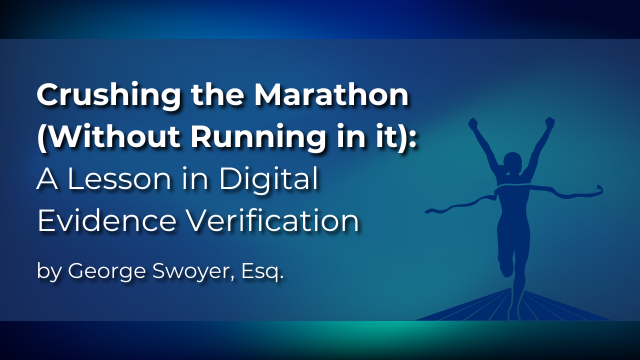
[EDRM Editor’s Note: The opinions and positions are those of George Swoyer, Esq. All images in the article are courtesy of the author.]
I was recently in Chicago for Relativity Fest 2025 and completed a sunrise run around Navy Pier during the week. Let me be clear, I did NOT stay in town to participate in the 47th running of the Chicago Marathon. I did, however, stand directly in front of a promotional billboard being installed in the hotel lobby as I was checking out stating “I crushed the Chicago Marathon.” This is a reminder of how easily images can mislead a viewer.

That sign got me thinking about a clear risk. An image and timestamp may appear as factual proof, but do not take these at face value, they are clearly not foolproof evidence. Photos and videos can be staged, manipulated, or misinterpreted. Timestamps and EXIF metadata can be edited by bad actors. A photo alone could easily mislead a viewer scrolling by on social media.
And with the rise of AI image generation and easy metadata editing tools, the risks are only increasing. While I did not spend time attempting to get the photo below to look like me, it demonstrates how AI can easily generate realistic and deceptive images.

Limits of Photo and Video Evidence
- Context is important and real photos can be visually deceptive.
- Metadata can be altered.
- AI makes fabricating evidence simple. Convincing photo evidence can now be created in just minutes and is often nearly indistinguishable from authentic images.
- Video evidence is not immune either with the prolific rise of deepfakes and edited clips. Relying on the adage of “seeing is believing” is a more dangerous assumption than ever.
Convincing photo evidence can now be created in just minutes and is often nearly indistinguishable from authentic images.
George Swoyer, Esq.
In forensic collections and litigation, defensibility requires more than just accepting a picture or a timestamp as proof. When receiving and analyzing digital data, we need be skeptical of what is being presented and ask for corroboration when needed.
Checklist for Validating Photo/Video Evidence
Below is a quick check list of five (5) facts I always recommend be considered when validating photo/video evidence:
- Ask for original, native files when available, rather than a screenshot. Screenshots can strip or alter metadata and may omit key details.
- Review the EXIF metadata (DateTimeOriginal, Device GPS) but treat this as one data point and not definitive proof.
- When there is doubt of an image’s authenticity, complete a reverse image search to determine if prior versions or duplicate copies of the image may exist.
- Corroborate the image with telemetry (phone location history, fitness apps, Waze/Google), server logs or witness statements.
- When involved in a high stakes matter, involve a forensic analyst who can examine the device artifacts, review logs, and perform a full file system data extraction when merited.
Courts and regulators are increasingly scrutinizing digital evidence. A screenshot or photo without context may fail when challenged on its authenticity. By adopting strong validation practices, counsel and litigation support professionals can avoid costly recollections or disputes over spoliation, strengthen the reliability of evidence in hearings and motions, and demonstrate diligence to the court, opposing counsel and clients.
Conclusion: The Importance of Corroboration
My “marathon photo” was taken in lighthearted fun, but it is also a reminder that images alone do not tell the full story. Just as I did not run 26.2 miles, many photos circulated in litigation and seen in social media feeds do not reflect reality. As eDiscovery and forensic professionals, it is our responsibility to dig deeper and verify and corroborate media files to ensure the digital evidence we are relying on is defensible, complete, and true.
Assisted by GAI and LLM Technologies per EDRM GAI and LLM Policy.

